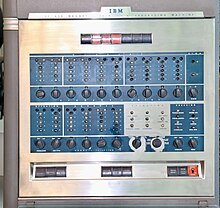 | |
 Part of the first IBM 650 computer in Norway (1959), known as "EMMA". 650 Console Unit (right, an exterior side panel is open), 533 Card Read Punch unit (middle, input-output). 655 Power Unit is missing. Punched card sorter (left, not part of the 650). Now at Norwegian Museum of Science and Technology in Oslo. | |
| Type | Digital computer |
|---|---|
| Release date | 1954 |
| Predecessor | IBM CPC (604, 605) |
| Successor | IBM 7070 (hi-end) IBM 1620 (low-end) |
| Related | IBM 701, IBM 702; IBM 608 |





The IBM 650 Magnetic Drum Data-Processing Machine is an early digital computer produced by IBM in the mid-1950s.[2][3] It was the first mass-produced computer in the world.[4][5] Almost 2,000 systems were produced, the last in 1962,[6][7] and it was the first computer to make a meaningful profit.[7] The first one was installed in late 1954 and it was the most popular computer of the 1950s.[8]
The 650 was offered to business, scientific and engineering users as a slower and less expensive alternative to the IBM 701 and IBM 702 computers, which were for scientific and business purposes respectively.[7] It was also marketed to users of punched card machines who were upgrading from calculating punches, such as the IBM 604, to computers.[1]: 5 [9]
Because of its relatively low cost and ease of programming, the 650 was used to pioneer a wide variety of applications, from modeling submarine crew performance[10] to teaching high school and college students computer programming. The IBM 650 became highly popular in universities, where a generation of students first learned programming.[11]
It was announced in 1953 and in 1956 enhanced as the IBM 650 RAMAC with the addition of up to four disk storage units.[12] The purchase price for the bare IBM 650 console, without the reader punch unit, was $150,000 in 1959,[13] or roughly $1,500,000 as of 2023. Support for the 650 and its component units was withdrawn in 1969.
The 650 was a two-address, bi-quinary coded decimal computer (both data and addresses were decimal), with memory on a rotating magnetic drum. Character support was provided by the input/output units converting punched card alphabetical and special character encodings to/from a two-digit decimal code.
The 650 was clocked at a frequency of 125 kHz.[14] It could add or subtract in 1.63 milliseconds, multiply in 12.96 ms, and divide in 16.90 ms. The average speed of the 650 was estimated to be around 27.6 ms per instruction, or roughly 40 instructions per second.[15]
Donald Knuth's series of books The Art of Computer Programming is famously dedicated to a 650.[15]
- ^ a b IBM 650 Magnetic Drum Data-Processing Machine: Manual of Operation (PDF). IBM. 1955. 22-6060-1.
- ^ "IBM Archives: IBM 650 installation with IBM 727 Magnetic Tape Unit and IBM 355 Disk Storage". IBM. US. Archived from the original on 2023-04-09. Retrieved September 5, 2019.
- ^ "IBM Archives: IBM 650 Assembly at Endicott plant". IBM. US. Archived from the original on 2023-10-23. Retrieved September 5, 2019.
- ^ "History Of Computers 1937-2011". Old Dominion University. Retrieved June 22, 2021.
- ^ "IBM in the Computer Era". The Minnesota Computing History Project. 28 June 2018. Retrieved June 21, 2021.
- ^ Pugh, Emerson W. (1995). Building IBM: Shaping an Industry and Its Technology. MIT Press. p. 182. ISBN 978-0-262-16147-3.
- ^ a b c "The IBM 650 Magnetic Drum Calculator". Columbia.edu.
- ^ Davis, Gordon B. (1971). Introduction to Electronic Computers (Second ed.). New York: McGraw-Hill. p. 10. ISBN 978-0-070-15821-4.
- ^ "IBM Archives: 650 Customers". IBM. Archived from the original on 2023-07-25.
- ^ Gray, Wayne D. (2007). Integrated Models of Cognition Systems. New York: Oxford University Press. p. 36. ISBN 978-0-19-518919-3.
- ^ "IBM 650 magnetic drum calculator introduced". Computerhistory.
- ^ "IBM Archives: 650 RAMAC announcement press release". IBM. Archived from the original on 2023-06-09.
- ^ "IBM Archives: IBM 650 Model 4 announcement press release". IBM. 2003-01-23. Archived from the original on 2023-10-23. Retrieved 2023-07-25.
- ^ Royse, David (1957). "The IBM 650 RAMAC system disk storage operation". Papers presented at the February 26-28, 1957, western joint computer conference: Techniques for reliability on - IRE-AIEE-ACM '57 (Western). ACM Press. pp. 43–49. doi:10.1145/1455567.1455576.
- ^ a b "Knuth Biographic Notes". softpanorama.org. Retrieved 2023-07-25.